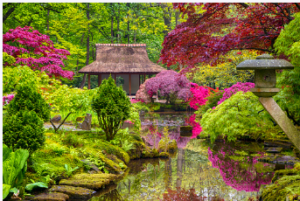Garden design is a unique art form that focuses on the relationship between people and nature. It includes large country houses and gardens, regional parks, suburban and urban gardens, and even rooftop decks.
 Garden Design South Australia often combine plants of various sizes and shapes. This great way to add interest to a flower bed without overwhelming the area.
Garden Design South Australia often combine plants of various sizes and shapes. This great way to add interest to a flower bed without overwhelming the area.
Colour
Colour is an essential element of garden design. From the calming effect of a palette of soft shades to a vibrant space filled with rich reds, oranges and lime greens, a colour is a powerful tool for changing the mood and feeling of a garden.
While there are many ways to approach colour in a garden, there are some basics that you should never forget. The most important is to choose the right colours for the feel you want to convey.
Yellow is a bold and brassy colour that catches the light and makes an area look brighter, but it should be used sparingly. Ideally, it would be best if you used it with lighter colours, such as purple or green, to diffuse its intensity.
Warm colours, such as red, fuchsia, and orange, pull the eye and are more potent than pastel versions of these colours. They are best used in areas people, such as entrances or focal points, will notice.
Excellent colours, such as blue, purple, and dark maroon, recede, suggesting a sense of movement or distance from the viewer. They are most effective when placed nearby or behind blues and greens, but they can also be used up close to add texture to a garden.
The most common colour schemes are complementary or opposite on the colour wheel; analogous, where two colours are next to each other on the wheel; and monochromatic, using tints and shades of one colour. These are all great strategies for a harmonious garden and can significantly impact your landscape.
Form
The form of a landscape is an essential element to consider when designing a garden. It reflects the space’s overall aesthetic and conveys a sense of identity that helps define certain styles.
The form is also a significant contributor to the attractive three-dimensional qualities of a garden. It includes the flow between outdoor areas, the topography of the landscape and more minor elements such as hedges, trees and foliage.
Using precisely trimmed geometric shapes like circles, squares and polygons in hardscape and plant materials define a space as formal, while irregular, flowing forms appear informal. For example, a retaining wall constructed of jagged stacked stone differs significantly from a row of rounded boxwoods that welcome you into the garden.
Shapes and forms also create contrast, another critical element of garden design. Strong contrasting forms can be as simple as repeating the same plants throughout the garden or as dramatic as using complete opposites in colour.
A garden without a strong underlying theme or rhythm is more confusing than a song without a refrain. The same goes for a landscape without solid and contrasting forms.
Texture
The texture is a critical Garden Design South Australia element that affects how a plant interacts with a garden’s lighting, shadows and contrast. It can also help a garden feel more spacious or layered.
A plant’s visual texture is determined by size, shape and leaf surface. Coarse-textured plants tend to have large leaves, irregular edges and thick stems or trunks. They are often profound in colour and can be thorny or spikey.
Fine-textured plants are usually those with thin, almost papery leaves and may have tiny stems and blooms in pastel colours. Many ornamental grasses and coreopsis fall into this category.
The fine texture of a plant’s foliage and stems is also what helps to define its form. For example, rounded and oval plants have neutral textures, while weeping and arching plants have a heavier texture.
Unity
There are many different elements in a garden that must work together to make it look good. Colour, forms, lighting, unique features and hardscapes are just a few design elements that must be incorporated into your landscape to produce unity in your design.
One of the easiest ways to create a sense of unity in your landscape is through repetition. Repetition can be achieved using the same plant family, similar colours or a repeating theme. It also can be created by repeating patterns of material and decor in your design.
Studying other structures in your neighbourhood and community is essential when creating a garden design. Take notes on the type of plants used, how they were placed, and what landscaping style is used. You can then use these examples as inspiration to design your landscape.
The form is an essential determinant of a formal or informal garden design. Geometric forms are typical of formal gardens, while organic forms are found in more naturalistic gardens. While one or two strikingly different forms may be an excellent way to achieve contrast and emphasis, the entire park should have some form of compatibility for unity in your design.
Proportion is the ability of a design to be scaled to fit within a space. For example, the size of water features, fences, garden structures, and plant groupings all need to be proportionate with the rest of the landscape so that the eye is brought around the space without feeling that it is being squeezed or restricted in any way.
Balance is the ability of a design to be balanced, using different elements that have almost the same imaginary weight. Typically this balance is achieved through symmetrical balance where two sides of the landscape are identical.